Ukiyo-e has matured in the 1800s. The world of ukiyo-e became more active than ever before in many aspects like increasing of the number of ukiyo-e artists, varieties of theme of ukiyo-e, skills of suri (printing) or hori (carving) and spread of ukiyo-e among ordinary people. Deformation by exaggeration or euphemistic became to be seem in the style of ukiyo-e and gorgeous works with many colors were preferred.
In 1830s, a chemical dye called bero-ai (ai means indigo-blue) that was imported from Europe was started to be used and works using bero-ai effectively were created. “Fugaku Sanjūrokkei” (Thirty-six Views of Mount Fuji) by Katsushika Hokusai or “Tōkaidō Gojū-san tugi” (Fifty-three Stations of the Tokaido Road) by Utagawa Hiroshige were the famous works that using bero-ai, but artists such as Utagawa Kunisada or Utagawa Kuniyoshi who leaded the world of ukiyo-e in the end of the Edo period also created art works using bero-ai very effectively. The nishiki-e colored by ai mainly is called ai-zuri and became one of masterpieces of ukiyo-e created in the end of the Edo period.
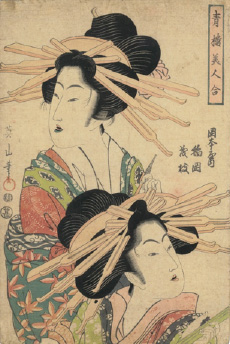
Kikukawa Eizan
“Seirō Bijin Awase Okamotoya uchi Inaoka Shige-eda”
Around Bunsei period (1818~30)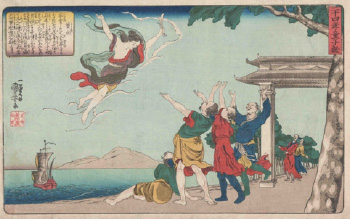
Utagawa Kuniyoshi
“Nijū-shi-kō Dōji Kagami Tōei”
End of Tenpō ~ Beginning of Kōka period (1840s)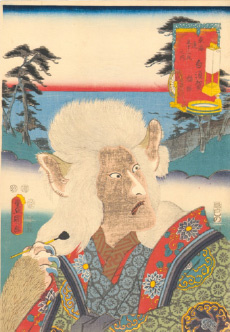
Utagawa Kunisada
“Tōkaidō Gojū-san tugi no uchi Shirasuka Nekozuka”
Kaei 5th (1852)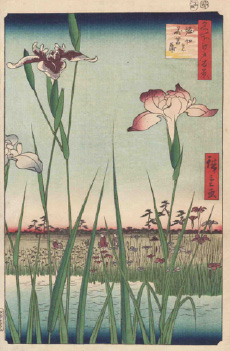
Utagawa Hiroshige
“Meisho Edo Hyakkei Horikiri no Hanashōbu”
Ansei 4th (1857)
- Utagawa KunisadaOpen or Close
In a long period from the latter part of the Edo period to the Meiji period, the Utagawa-ha whose founder was Utagawa Toyoharu (1735~1814) was the first party of the world of ukiyo-e. In the times of Toyokuni (1769~1825) who studied under Toyoharu, the foundations for yakusha-e (ukiyo-e of actor) or bijin-ga (ukiyo-e of beautiful woman) was laid and many excellent artists were produced from the party. Among those artists, Kunisada took over the Utagawa party which was firmed up by Toyokuni practically and played an active role till the last days of the Tokugawa Shogunate.
Kunisada was good at yakusha-e and bijin-ga. Especially the bijin-ga which was created in the period of “Bunka Bunsei” (1804~1829) are highly regarded as the art works that expressed the iki (smart or stylishness) of Edo in a dignified style.-
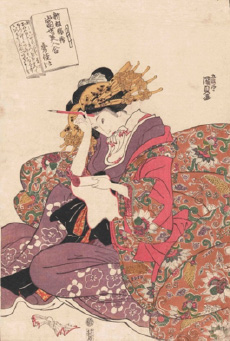
“Shin-ban Nishiki-e Tōse Bijin Awase Hideka Kidori”
Around Bunka 12th (1815) -
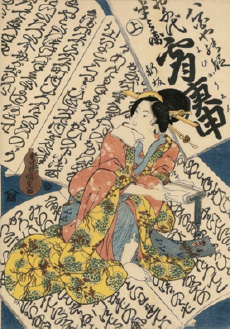
“Jōruri Zukushi Ochiyo Hanbē Yoigōshin”
Around Bunka 10th ~ Tenpō 13th (1813~1842) -
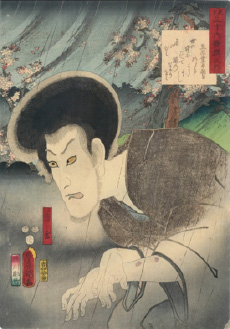
“Mitate Sanjū-rokkasen no uchi Seigen”
Kaei 5th (1852) -
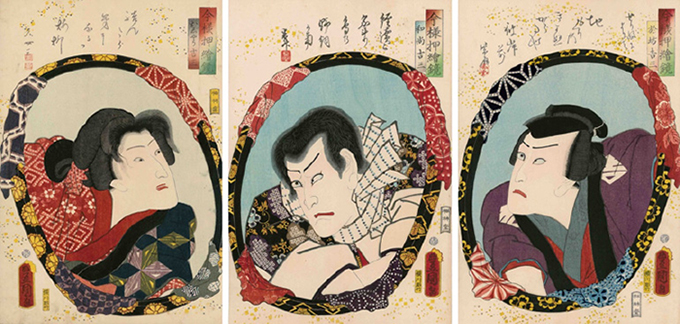
“Imayō Oshie Kagami Ojō-Kichisa Oshō-Kichisa Obō-Kichisa”
Ansei 6th (1859)
He also was very good at illustrations of kusazōshi (a book of novel with illustration, for ordinarily people). “Nise Murasaki Inaka Genji” which was published by Senkaku-dō, written by Ryūtei Tanehiko and illustrated by Kunisada was a dominant influence at that time and leaded the boom of genji-e after that. His sophisticated and munificent style got a great reputation especially among women and he kept his popularity.
-
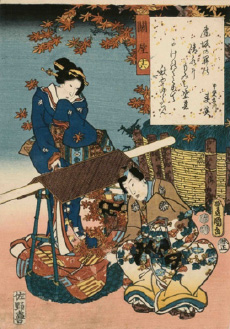
“Ima-genji Nishiki-e Awase Sekiya”
Kaei 5th ~ Ansei 1st (1852~1854) -
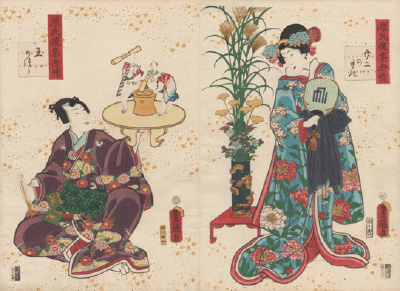
“Genji Goshū Yojō Nijū-ni no maki Tama-kazura”
Ansei 6th (1859)
-
- Utagawa KuniyoshiOpen or Close
As same as Kunisada, Utagawa Kuniyoshi (1797~1861) studied under Utagawa Toyokuni. But not same as Kunisada, he played an active role in the fields of musha-e (ukiyo-e of warrior), kachō-ga (ukiyo-e of flowers, birds or living things except human being), hūshi-ga (caricature ukiyo-e) and so on. The series of “Tūzoku-suiko-den Gōketu Hyaku-hachi-nin no Hitori” which was published from 1827 became very popular and leaded to create a new field of musha-e in the world of ukiyo-e. The most unique points about him are his original idea and bold composition. His powerful and energetic style which is seen in “Miyamoto Musashi to Kyo-gei” (Miyamoto Musashi and a huge whale) or “Sōma no Hurudairi” was welcomed with surprise by the people in Edo. And Kuniyoshi is well known as a cat-lover and created many ukiyo-e whose theme is a cat.

“Tsūzoku Suikoden Gōketu Hyaku-hachi-nin no Ikko Kokusenpū Riki Ichimei Ri Tetugyū”
Bunsei 10th (1827)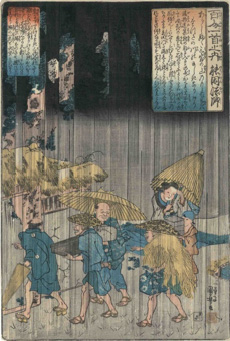
“Hyakunin-Isshu no uchi Nōin-hōshi”
Around Tenpō 11th ~ 13th (1840~1842)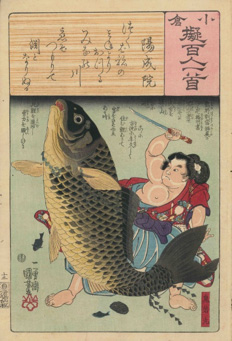
“Ogura Nazorae Hyakunin-Isshu Yōzei-in Oniwakamaru”
Around Kōka 3rd (1846)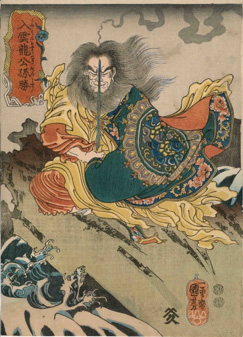
“Tsūzoku Suikoden Gōketu Hyaku-hachi-nin no uchi Nyū-un-ryū Kōson Shō”
Around the beginning of Kaei (1848~1852)- “Morokoshi Niju-shi-kō Gomō Taishun”

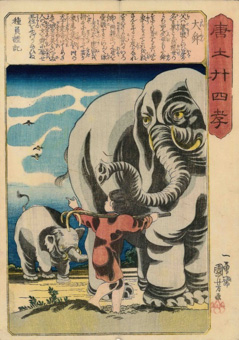
Kaei period (1848~54) 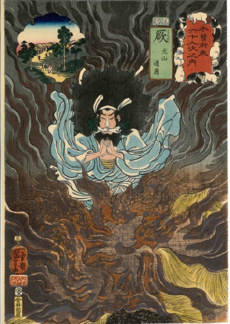
“Kiso Kaidō Rokujū-kyū tsugi no uchi Warabi Inuyama-dōsetu”
Kaei 5th (1852)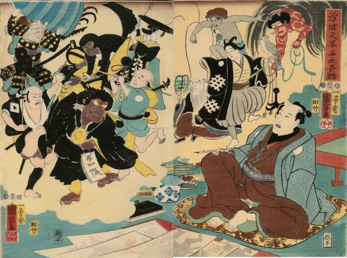
“Ukiyo Matahei Meiga no Kidoku”
Kaei 6th (1853)
- Utagawa HiroshigeOpen or Close
Utagawa Hiroshige (1797~1858) was used to be introduced as Andō Hiroshige. Hiroshige was born in the family of bushi. The family name “Andō” stood for the family who worked for the government as firefighting. And his last name is Tokubē. The name “Hiroshige” was given to him as a gagō (a pseudonym) by his teacher Toyohiro. Then the name “Andō Hiroshige” is the mixture of his real family name and his pseudonym. So now, he is called “Utagawa Hiroshige” usually.
The teacher of Hiroshige is Utagawa Toyohiro (1776~1828). Toyohiro and Toyokuni had the same teacher Utagawa Toyoharu who was the originator of Utagawa party. Compared with Toyokuni, Toyohiro’s style is simple but his bijin-ga with neat and clean women are very sophisticated. And Toyohiro didn’t create so many yakusha-e. Under such teacher, some pupils created hūkei-ga (landscape ukiyo-e) or hūzoku-ga (ukiyo-e of custom). And Hiroshige was one of them.
The landscape print “Tōto Meisho” which was published in 1831 brought him recognition and he was 35 years old at that time. The crimson cloud, the sky, river and sea that are expressed with bero-ai bear a close resemblance to his landscape master pieces that were created after that. In 1833, he got a huge popularity by “Tōkaidō Gojū-san tugi” in Hoeidō version. After that, he created many landscape of Kiso, Ōmi, Osaka, Edo and so on.
The expansion of the series that do not lose people’s interests by deliberated composition or limited color is the unique world of Hiroshige. Hiroshige was also very good at naiveté and cute kachō-ga. There are many master pieces that express his warm personality or gentle eyes on nature.-
“Tōkaidō Gojū-san tugi no uchi (Kyōka-iri) Hara Shimada Hujikawa Ishiyakushi”
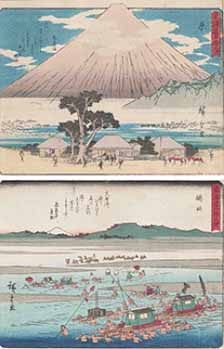

Tenpō 11th (1840) 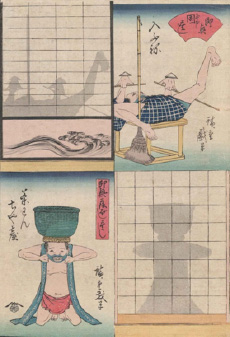
“Sokkyō Kageboshi Zukushi Irihune Chawan to Chadai”
Around Tenpō 10th ~ 13th (1839~1842)-
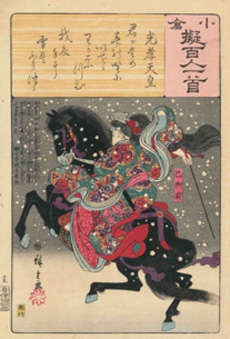
“Ogura Nazorae Hyakunin-Isshu Kōkō-tennō Tomoe-gozen”
Around Kōka 3rd (1846) -
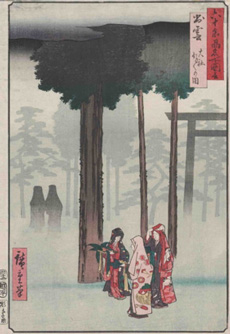
“Rokujū-yo-shū Meisho Zu-e Izumo-taisha Hotohoto no Zu”
Kaei 6th (1853) -
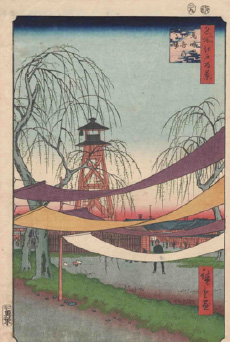
“Meisho Edo Hyakkei Bakurōchō Hatune no Baba”
Ansei 4th (1857) -
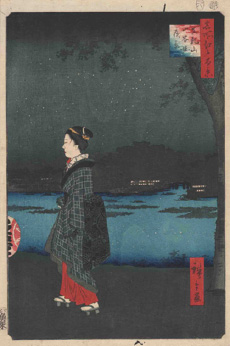
“Meisho Edo Hyakkei Matuchi-yama San-ya-bori Yakei”
Ansei 4th (1857) -
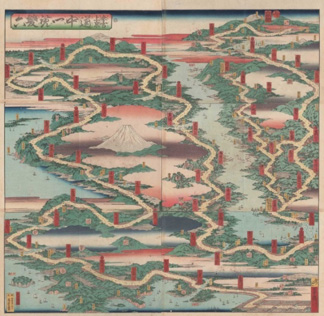
“Sangū Jōkyō Dōchū Ichiran Sugoroku”
Ansei 4th (1857)
-
